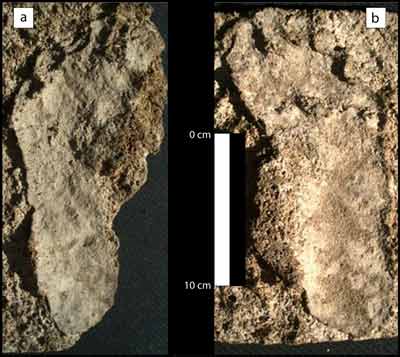“Our reported footprint date is not only the oldest human fossil evidence, but also the oldest archaeological evidence, reported from the Cuatro Ciénegas Basin.” – Dr. Nicholas Felstead, a geoarchaeologist with Durham University.
![Part of the Chihuahuan Desert in Mexico, where the prints were found. [PHOTO: apogeephoto.com]](https://historythings.com/wp-content/uploads/2016/09/xmas-day.jpg)
Part of the Chihuahuan Desert in Mexico, where the prints were found. [PHOTO: apogeephoto.com]
The year was 1961. Just 300 kilometers from the border between Texas and Mexico a set of fossilized human footprints was found by some construction workers working on a highway in Northeastern Mexico, in the Chihuahuan Desert. The prints were excavated by a team of archaeologists and sent to a local museum, but the researchers in the 1960s never took records of where, exactly, the prints were found. Their location was completely forgotten.
Archaeological artifacts and fossils simply aren’t valuable if the location they were found in is forgotten. They’re usually impossible to date without the surrounding soil, and if there’s no evidence that they were discovered on-site, they can be easily written off as a hoax.
Researchers began to search for the original site in 2006, but came back empty-handed. The researchers were able to find eleven more sets of tracks, however, in the general vicinity where the fossilized tracks were found.
“Both sets of prints are ones that have been identified before and are the only reported footprints in the Cuatro Ciénegas Basin, but neither have previously been dated,” Dr. Felstead said.
Felstead and his team set about to correct that oversight. Luckily for them, they now knew the general location where the tracks belonged, and, even more importantly, they discovered the tracks had been fossilized in travertine.

PHOTO: westerndigs.org
Travertine is a sedimentary rock that contains traces of uranium from water. The site where the tracks were found had been a marshy, spring-fed oasis in the midst of the desert. This was a fortunate find for Dr. Felstead and his team.
Uranium has a predictable rate of decay. Using this rate and comparing it to the amount of uranium left in the stone, researchers were able to date the footprints. Their results were shocking. The pair of tracks discovered in 1961 were over ten-thousand years old. The other prints from the set of eleven dated back 7,250 years according to the same test.
“To my knowledge the oldest human prints previously reported in North America are around 6,000 years old, so the… prints pre-date these by some 5,000 years.” – Dr. Nicholas Felstead.
Not only are these prints an immense find for the archaeological community, they also provide insight into how the ancient culture who once inhabited the area lived, and the challenges they faced.
The Cuatro Ciénegas Basin was once home to the Coahuiltecan culture. At first, they began as a band of hunter-gatherers. It’s a culture that’s not very well understood by archaeologists because they left very little behind in terms of dateable evidence, making these tracks immensely valuable. Not only do they provide a date, but the prints also contained traces of pollen from the plants that were living in the area when the tracks were created. The pollen was from both pecan and willow trees – trees that survive in wet, cool environments, suggesting that somewhere along the 10,000 year-old timeline, this area of Mexico was once a forest that eventually morphed into the arid desert it is today.
“As the ancient nomadic hunter-gatherers needed to adapt to the increasingly hostile desert conditions,” Dr. Falstead and his team wrote in their report, “they expanded their ability to find resources, leading to longer cycles of nomadism and possibly the expansion of their unique desert culture right into the 18th Century when they finally become extinct after the arrival of the Europeans.”
The area where the tracks were found will continue to be analyzed in hopes of finding more evidence of this ancient culture. Falstead and his team have published their findings in the Journal of Archaeological Science.

